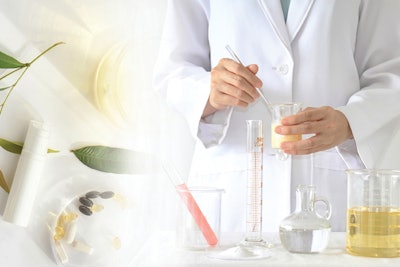 [Images: Getty Images]
[Images: Getty Images]A rundown of current technologies, plus new and noteworthy developments to look out for.
Describing the activities and effects of topical skincare products once they make contact with the skin can be challenging for manufacturers and practitioners. After all, with the exception of most sunscreens, which are purposefully formulated to remain on the skin’s surface, consumers are looking for products that can penetrate and do something. Thus, the imperative that has kept manufacturers’ R&D experts extremely busy over the past 20 years is the development of effective delivery systems: methods by which certain key ingredients are able to gain access to the skin’s deeper layers to effect change.
“Effecting change” is where the tricky part comes in. Although the U.S. Food and Drug Administration (FDA) doesn’t currently regulate the manufacture of cosmetic products, it does strictly differentiate them from drugs (which the agency, of course, does regulate) by laying out specific definitions for each category based on the intended use. Per the FDA, cosmetics are intended to beautify or promote attractiveness, and drugs are intended to affect the structure or function of the body—and that includes the skin. Therefore, if a product marketed as a cosmetic is shown—or purported—to actually alter the skin’s inner structures or functions, it’s crossing over into drug territory and is subject to a completely different set of legal criteria.
RELATED: Experts Reveal Why Lipids are a Skincare All-Star
But are things really that black and white? Most likely not—let’s just say that the FDA currently does not recognize in-between terms such as “cosmeceuticals” as a category. So, as it stands today, the very real progress that skincare formulators are making in innovative product delivery systems—particularly in the realm of antiaging—is muted by these legal definitions, prompting many skincare manufacturers to consult regulatory experts who help them stay within their legal parameters in terms of marketing claims and product descriptions. “We have three regulators in our R&D,” reports Lydia Sarfati, founder and CEO of Repêchage. “They scrutinize everything we say, write and talk about because it’s necessary when you want to be working within the law.” She notes that Canada has created separate categories for “cosmetics” and “functional cosmetics,” designations that Sarfati and many others in the industry feel are long overdue in the U.S. Clearly, any responsible discussion of product delivery systems in U.S.-marketed skin care should operate within the parameters of current FDA guidelines. That said, science is science and progress is progress. Working on the same level playing field, cosmetics formulators share the many ways in which they’re able to deliver key ingredients to the skin and yield visible improvements in tone, texture and overall condition.

Ways to Deliver
Here’s a brief rundown of current product delivery technologies, from the tried-and-true to the cutting-edge:
Emulsions – Emulsions are formed when droplets of one liquid are combined with another liquid that isn’t soluble (think: oil and vinegar). Skincare chemists use a basic emulsion to serve as a carrier to enable stability of the formula, setting the scene for the addition of active ingredients. “The base of the product, or type of emulsion, is a very important player that can influence how delivery systems work and whether or not they’re capable of producing benefits,” says Christian Jurist, MD, medical director of global education for Pevonia International.
RELATED: Proper Skin Cleansing Advice For Your Clients
Emulsions come in many forms. Eric Chillseyzn, senior VP of research and development/CTO for Glycelene and Borio Beauty, is partial to the liquid crystal emulsion, which has a layered structure that he says provides “excellent active stability and delivery with minimal disruption of the dermal barrier.” There are also microemulsion formulas in which the drops are so small the product often appears transparent.
Dr. Jurist points to the ability of a time-release or triphase (also called multiple) microemulsion to enhance results.
Serums – Serums are specifically formulated to be lightweight and quickly absorbed, enabling key ingredients to easily penetrate outer layers of the skin. Serums are usually water-based because the presence of oil is likely to slow absorption and even occlude the skin’s surface, and they are highly concentrated to deliver brighteners, antioxidants, peptides, etc., as eectively as possible.
Alcohol systems – As an ingredient in skin care, alcohol has an understandably negative reputation for drying and irritating the skin. However, not all alcohols are created equal; so-called fatty alcohols (cetyl, stearyl, behenyl and cetearyl) are derived from vegetables and actually have an emollient effect—but, thanks to their molecular structure, they can still penetrate the barrier layer and act as effective carriers.
RELATED: Spa Pros Reveal the Benefits of Retinol
Microencapsulation – True to its name, microencapsulation calls for the key ingredient to be encased in the formulation and then released into the skin when applied. This delivery method, explains G.M. Collin’s director of education Karen Asquith, “prohibits the breakdown of the active and also provides a slower release into the skin, thus reducing sensitivity and irritation.” This technology has been around for years, notes Chillseyzn. “One

The transdermal delivery of key ingredients is usually associated with prescription and over the counter (OTC) medications, but it has been marketed
in skin care since the 1990s. Its goal is to “push” ingredients deeply into the skin in a controlled fashion. Lately the technology is gaining popularity in the use of facial masks. “Many mask patches contain the active ingredients on one side with with an occlusive material on the external side, thus increasing the penetration into the skin,” explains Asquith. A key challenge with molecular patches is regulating the depth of penetration. “Skincare actives generally need to be delivered to specific layers of the skin to be effective, which means limited migration,” says Chillseyzn. “You don’t want these ingredients to reach the blood stream where they quickly get dispersed through the body and are rendered useless.”
Nanotechnology – When applied to skin care, the term “nanotechnology” is often misunderstood. “Truthfully, ‘nano’ describes anything smaller than a micron, and most active materials are already ‘nano,’” explains Chillseyzn. “The term actually refers to bringing the whole delivery vehicle down to nanoparticle size.” For example, a nanoemulsion is an emulsion whose droplets are smaller than those of a microemulsion. Nanotechnology is considered controversial, particularly when used in SPFs (“where any penetration is too much,” opines Chillseyzn), and there are strong opinions on both sides of the debate. However, it’s generally agreed that the product penetration potential of nanotechnology needs to be taken seriously and handled judiciously.
Drone (hypertargeted) technology – The goal for drone technology in skin care, says Dr. Jurist, is to “very precisely deliver actives into cells where specific molecules that attach to cell proteins ‘signal’ the encapsulated active, telling it where to specifically reach and interact.” This new technology, says Asquith, “utilizes ligands [neutral molecules] that bind exclusively to the desired receptor,” which enables the drone to penetrate.
Special Deliveries
Just as certain ingredients can combine harmoniously in a single skincare formula, multiple delivery systems can be employed to optimize results. “For example, you can have the advantage of a time-release microemulsion as a base for the bulk of ingredients that can also contain icroencapsulation to target actives more specifically, and keep them isolated if necessary for optimal potency, protection, duration and maximum benefits,” says Dr. Jurist.
According to Chillseyzn, most delivery systems would be viewed as “multiple” if they were broken down enough. “Nano systems and micro systems will generally need a carrier, such as an emulsion or an aqueous gel, so they will always be in a partnership,” he says. “One example of multiple delivery vehicles would be the liposomal microencapsulation of a nanoparticle active delivery in an oil-water-silicone triple emulsion. Is that a thing? Probably not. But it’s definitely possible.”
–by Linda Kossoff











